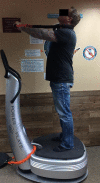Alleviation of posttraumatic dizziness by restoration of the cervical lordosis: a CBP® case study with a one year follow-up
- PMID: 29765191
- PMCID: PMC5940483
- DOI: 10.1589/jpts.30.730
Alleviation of posttraumatic dizziness by restoration of the cervical lordosis: a CBP® case study with a one year follow-up
Abstract
[Purpose] To present the successful treatment of posttraumatic dizziness and neck pains that were initiated in a patient following a whiplash event. [Subject and Methods] A 46 year old male suffered a whiplash event that initiated neck pain and dizziness symptoms. The patient had many positive orthopedic findings and demonstrated a forward head posture and cervical hypolordosis. The patient was treated by Chiropractic BioPhysics® technique including cervical extension traction, extension exercises and spinal manipulative therapy initially three times a week for 16-weeks, and once a month thereafter. [Results] The patient had a resolution of daily dizziness and neck pain with a concomitant reduction of forward head translation and increase in cervical lordosis. The postural measures were further improved after one year of mostly home-care. [Conclusion] The cervical spine alignment may be an important biomarker for those with dizziness. The correction of cervical lordosis may be an essential requirement for superior clinical outcomes for those with posttraumatic dizziness.
Keywords: Cervical lordosis; Extension traction; Posttraumatic dizziness.
Figures



References
-
- Hogue JD: Office evaluation of dizziness. Prim Care, 2015, 42: 249–258. - PubMed
-
- Byrne M: Assessment of the dizzy patient. Aust Fam Physician, 2002, 31: 722–727. - PubMed
-
- Fitzgerald DC: Head trauma: hearing loss and dizziness. J Trauma, 1996, 40: 488–496. - PubMed
-
- Spitzer WO, Skovron ML, Salmi LR, et al. : Scientific monograph of the Quebec Task Force on Whiplash-Associated Disorders: redefining “whiplash” and its management. Spine, 1995, 20: 1S–73S. - PubMed
-
- Grauer JN, Panjabi MM, Cholewicki J, et al. : Whiplash produces an S-shaped curvature of the neck with hyperextension at lower levels. Spine, 1997, 22: 2489–2494. - PubMed
Publication types
LinkOut - more resources
Full Text Sources
Other Literature Sources
